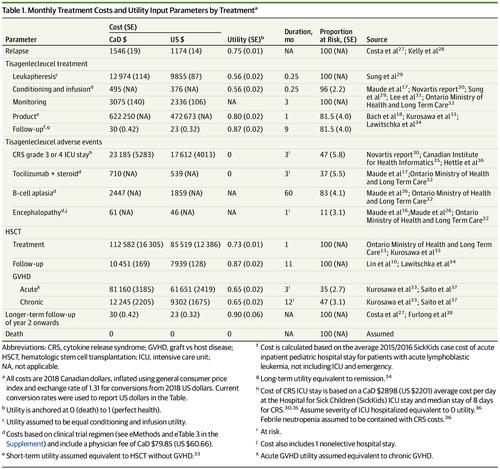当前位置:
X-MOL 学术
›
JAMA Oncol.
›
论文详情
Our official English website, www.x-mol.net, welcomes your feedback! (Note: you will need to create a separate account there.)
Cost-effectiveness of Tisagenlecleucel vs Standard Care in High-risk Relapsed Pediatric Acute Lymphoblastic Leukemia in Canada.
JAMA Oncology ( IF 28.4 ) Pub Date : 2020-01-23 , DOI: 10.1001/jamaoncol.2019.5909 Jill Furzer 1, 2 , Sumit Gupta 3, 4 , Paul C Nathan 2, 3 , Tal Schechter 3, 4 , Jason D Pole 5 , Joerg Krueger 3, 4 , Petros Pechlivanoglou 1, 2
JAMA Oncology ( IF 28.4 ) Pub Date : 2020-01-23 , DOI: 10.1001/jamaoncol.2019.5909 Jill Furzer 1, 2 , Sumit Gupta 3, 4 , Paul C Nathan 2, 3 , Tal Schechter 3, 4 , Jason D Pole 5 , Joerg Krueger 3, 4 , Petros Pechlivanoglou 1, 2
Affiliation

|
Importance
Tisagenlecleucel, a chimeric antigen receptor T-cell therapy for relapsed or refractory pediatric acute lymphoblastic leukemia, has been approved for use in multiple jurisdictions. The public list price is US $475 000, or more than CaD $600 000. Assessing the cost-effectiveness of tisagenlecleucel is necessary to inform policy makers on the economic value of this treatment.
Objective
To assess the value for money of tisagenlecleucel compared with current standard care for tisagenlecleucel-eligible pediatric patients with acute lymphoblastic leukemia under unknown long-term effectiveness.
Design, Setting, and Participants
A cost-utility analysis of tisagenlecleucel compared with current standard care using a Canadian population-based registry of pediatric patients with acute lymphoblastic leukemia was performed. Results from 3 pooled single-arm tisagenlecleucel clinical trials and a provincial pediatric cancer registry were combined to create treatment and control arms, respectively. The population-based control arm consisted of patients meeting clinical trial inclusion and exclusion criteria, starting at second relapse. Multistate and individual-level simulation modeling were combined to predict patient lifetime health trajectories by treatment strategy. Tisagenlecleucel efficacy was modeled across long-term cure rates, from 10% to 40%, to account for limited information on its long-term effectiveness. Uncertainty was tested with 1-way and probabilistic sensitivity analysis. Data were collected in September 2017, and analysis began in December 2017.
Exposures
Tisagenlecleucel compared with current standard care for tisagenlecleucel-eligible patients.
Main Outcomes and Measures
Relative health care costs, survival gains, and quality-adjusted life-years (QALYs) between tisagenlecleucel and current standard care.
Results
The treatment and control arms were modeled on 192 and 118 patients, respectively. The mean (SD) age of control individuals was 10 (4.25) years, and the mean (SD) age of the pooled clinical trial sample was 11 (6) years. The control individuals had 78 boys (66%), and the pooled clinical trial sample had 102 boys (53%). Treatment with tisagenlecleucel was associated with an additional 2.14 to 9.85 life years or 1.68 to 6.61 QALYs, compared with current care. The average additional cost of tisagenlecleucel was CaD $470 013 (US $357 031). Accounting for the total discounted cost over the patient lifetime resulted in an incremental cost of CaD $71 000 (US $53 933) to CaD $281 000 (US $213 453) per QALY gain.
Conclusions and Relevance
To our knowledge, this study offers the first cost-effectiveness analysis of tisagenlecleucel compared with current standard care for pediatric patients with acute lymphoblastic leukemia using a constructed population-based control arm. At a willingness-to-pay threshold of $150 000/QALY, tisagenlecleucel had a 32% likelihood of being cost-effective. Tisagenlecleucel cost-effectiveness would fall below $50 000/QALY with a long-term cure rate of over 0.40 or a price discount of 49% at its currently known effectiveness.
中文翻译:

Tisagenlecleucel与标准治疗在加拿大高危复发小儿急性淋巴细胞白血病中的成本效益。
重要性Tisagenlecleucel是一种用于复发性或难治性小儿急性淋巴细胞白血病的嵌合抗原受体T细胞疗法,已获批准在多个辖区使用。公开定价为47.5万美元,或超过60万加元。要评估政策制定者有关这种治疗的经济价值,必须评估替沙亨单核细胞的成本效益。目的评估在长期疗效不明的情况下,替萨根细核细胞治疗的符合条件的符合替萨根细核细胞治疗的小儿急性淋巴细胞白血病患者的经济价值。设计,设置和参与者采用加拿大人群为基础的急性淋巴细胞白血病小儿患者登记系统,比较了替沙gen小核素与当前标准治疗的成本效用分析。将3项合并的单臂tisagenlecleucel临床试验的结果与省级儿科癌症登记处的结果相结合,分别创建了治疗组和对照组。从第二次复发开始,基于人群的对照组由符合临床试验纳入和排除标准的患者组成。多状态和个人级别的仿真模型相结合,通过治疗策略来预测患者的终生健康轨迹。Tisagenlecleucel的功效是在10%至40%的长期治愈率中建模的,以解释其长期功效的有限信息。用1向和概率敏感性分析测试不确定性。2017年9月收集了数据,分析于2017年12月开始。暴露于Tisagenlecleucel的患者与符合tisagenlecleucel资格的患者当前的标准护理相比。主要结果和衡量指标:三苯三氮菁与现行标准治疗之间的相对医疗保健成本,生存收益以及质量调整的生命年(QALY)。结果治疗组和对照组分别建模为192例和118例患者。对照个体的平均(SD)年龄为10(4.25)岁,合并的临床试验样本的平均(SD)年龄为11(6)岁。对照个体有78个男孩(占66%),合并的临床试验样本有102个男孩(占53%)。与目前的治疗相比,使用替萨根微核素治疗可额外增加2.14至9.85个生命年或1.68至6.61个QALY。替萨根核糖核酸的平均额外费用为470 013加元(约合357 031美元)。考虑到患者生命周期内的总折现成本,每QALY收益使费用增加了7.1万加元(约合53 933美元)至281 000加元(约合213 453美元)。结论和相关性据我们所知,本研究提供了蒂沙君子核素与目前标准的小儿急性淋巴细胞性白血病患者的成本效益分析,采用了基于人群的对照组。在愿意支付的门槛为$ 150 000 / QALY的情况下,替萨根微细胞有32%的可能性具有成本效益。Tisagenlecleucel的成本效益将降至$ 50 000 / QALY以下,长期治愈率超过0.40或以其目前已知的效率进行49%的价格折扣。这项研究提供了基于现有人群控制组的替沙可君莱克尔与当前标准治疗相比,小儿急性淋巴细胞性白血病患者的首次成本效益分析。在愿意支付的门槛为$ 150 000 / QALY的情况下,替萨根微细胞有32%的可能性具有成本效益。Tisagenlecleucel的成本效益将降至$ 50 000 / QALY以下,长期治愈率超过0.40或以其目前已知的效率进行49%的价格折扣。这项研究提供了基于现有人群控制组的替沙可君莱克尔与当前标准治疗相比,小儿急性淋巴细胞性白血病患者的首次成本效益分析。在愿意支付的门槛为$ 150 000 / QALY的情况下,替萨根微细胞有32%的可能性具有成本效益。Tisagenlecleucel的成本效益将降至$ 50 000 / QALY以下,长期治愈率超过0.40或以其目前已知的效率进行49%的价格折扣。
更新日期:2020-03-12
中文翻译:

Tisagenlecleucel与标准治疗在加拿大高危复发小儿急性淋巴细胞白血病中的成本效益。
重要性Tisagenlecleucel是一种用于复发性或难治性小儿急性淋巴细胞白血病的嵌合抗原受体T细胞疗法,已获批准在多个辖区使用。公开定价为47.5万美元,或超过60万加元。要评估政策制定者有关这种治疗的经济价值,必须评估替沙亨单核细胞的成本效益。目的评估在长期疗效不明的情况下,替萨根细核细胞治疗的符合条件的符合替萨根细核细胞治疗的小儿急性淋巴细胞白血病患者的经济价值。设计,设置和参与者采用加拿大人群为基础的急性淋巴细胞白血病小儿患者登记系统,比较了替沙gen小核素与当前标准治疗的成本效用分析。将3项合并的单臂tisagenlecleucel临床试验的结果与省级儿科癌症登记处的结果相结合,分别创建了治疗组和对照组。从第二次复发开始,基于人群的对照组由符合临床试验纳入和排除标准的患者组成。多状态和个人级别的仿真模型相结合,通过治疗策略来预测患者的终生健康轨迹。Tisagenlecleucel的功效是在10%至40%的长期治愈率中建模的,以解释其长期功效的有限信息。用1向和概率敏感性分析测试不确定性。2017年9月收集了数据,分析于2017年12月开始。暴露于Tisagenlecleucel的患者与符合tisagenlecleucel资格的患者当前的标准护理相比。主要结果和衡量指标:三苯三氮菁与现行标准治疗之间的相对医疗保健成本,生存收益以及质量调整的生命年(QALY)。结果治疗组和对照组分别建模为192例和118例患者。对照个体的平均(SD)年龄为10(4.25)岁,合并的临床试验样本的平均(SD)年龄为11(6)岁。对照个体有78个男孩(占66%),合并的临床试验样本有102个男孩(占53%)。与目前的治疗相比,使用替萨根微核素治疗可额外增加2.14至9.85个生命年或1.68至6.61个QALY。替萨根核糖核酸的平均额外费用为470 013加元(约合357 031美元)。考虑到患者生命周期内的总折现成本,每QALY收益使费用增加了7.1万加元(约合53 933美元)至281 000加元(约合213 453美元)。结论和相关性据我们所知,本研究提供了蒂沙君子核素与目前标准的小儿急性淋巴细胞性白血病患者的成本效益分析,采用了基于人群的对照组。在愿意支付的门槛为$ 150 000 / QALY的情况下,替萨根微细胞有32%的可能性具有成本效益。Tisagenlecleucel的成本效益将降至$ 50 000 / QALY以下,长期治愈率超过0.40或以其目前已知的效率进行49%的价格折扣。这项研究提供了基于现有人群控制组的替沙可君莱克尔与当前标准治疗相比,小儿急性淋巴细胞性白血病患者的首次成本效益分析。在愿意支付的门槛为$ 150 000 / QALY的情况下,替萨根微细胞有32%的可能性具有成本效益。Tisagenlecleucel的成本效益将降至$ 50 000 / QALY以下,长期治愈率超过0.40或以其目前已知的效率进行49%的价格折扣。这项研究提供了基于现有人群控制组的替沙可君莱克尔与当前标准治疗相比,小儿急性淋巴细胞性白血病患者的首次成本效益分析。在愿意支付的门槛为$ 150 000 / QALY的情况下,替萨根微细胞有32%的可能性具有成本效益。Tisagenlecleucel的成本效益将降至$ 50 000 / QALY以下,长期治愈率超过0.40或以其目前已知的效率进行49%的价格折扣。


























 京公网安备 11010802027423号
京公网安备 11010802027423号